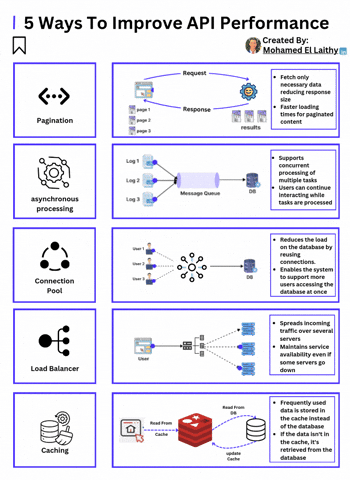Top 5 Effective Methods to Enhance API Performance
Pagination Implementing pagination helps manage large datasets efficiently by returning results in smaller chunks. This reduces response size, accelerates data retrieval, and improves the overall user experience. Asynchronous Logging Instead of writing logs to disk on every request, logs are temporarily stored in a buffer and written periodically. This minimizes I/O bottlenecks and enhances API responsiveness by reducing processing delays. Connection Pooling Maintaining a pool of reusable connections reduces the overhead of establishing new database connections repeatedly. This improves efficiency, decreases latency, and allows the system to handle a higher number of concurrent users. Load Balancer A load balancer efficiently distributes incoming requests among multiple servers, preventing any single server from being overwhelmed. This ensures better resource utilization, higher fault tolerance, and increased system availability. Caching Storing frequently requested data in a cache reduces the need for repeated database queries. Solutions like Redis improve response times by keeping frequently accessed data in memory, enhancing overall API speed. Over to you: What other ways do you use to improve API performance? follow me on LinkedIn for more animated software diagrams linkedin

Pagination
Implementing pagination helps manage large datasets efficiently by returning results in smaller chunks. This reduces response size, accelerates data retrieval, and improves the overall user experience.Asynchronous Logging
Instead of writing logs to disk on every request, logs are temporarily stored in a buffer and written periodically. This minimizes I/O bottlenecks and enhances API responsiveness by reducing processing delays.Connection Pooling
Maintaining a pool of reusable connections reduces the overhead of establishing new database connections repeatedly. This improves efficiency, decreases latency, and allows the system to handle a higher number of concurrent users.Load Balancer
A load balancer efficiently distributes incoming requests among multiple servers, preventing any single server from being overwhelmed. This ensures better resource utilization, higher fault tolerance, and increased system availability.Caching
Storing frequently requested data in a cache reduces the need for repeated database queries. Solutions like Redis improve response times by keeping frequently accessed data in memory, enhancing overall API speed.
Over to you: What other ways do you use to improve API performance?
follow me on LinkedIn for more animated software diagrams linkedin













































































































































































![[The AI Show Episode 142]: ChatGPT’s New Image Generator, Studio Ghibli Craze and Backlash, Gemini 2.5, OpenAI Academy, 4o Updates, Vibe Marketing & xAI Acquires X](https://www.marketingaiinstitute.com/hubfs/ep%20142%20cover.png)



























































































































![[FREE EBOOKS] The Kubernetes Bible, The Ultimate Linux Shell Scripting Guide & Four More Best Selling Titles](https://www.javacodegeeks.com/wp-content/uploads/2012/12/jcg-logo.jpg)



![From drop-out to software architect with Jason Lengstorf [Podcast #167]](https://cdn.hashnode.com/res/hashnode/image/upload/v1743796461357/f3d19cd7-e6f5-4d7c-8bfc-eb974bc8da68.png?#)





































































































.png?#)





.jpg?#)
































_Christophe_Coat_Alamy.jpg?#)










































































































![Rapidus in Talks With Apple as It Accelerates Toward 2nm Chip Production [Report]](https://www.iclarified.com/images/news/96937/96937/96937-640.jpg)





































































































































